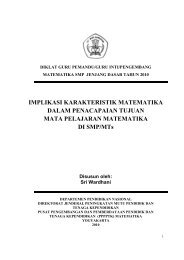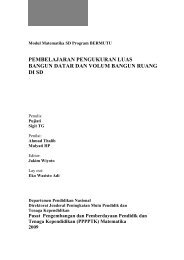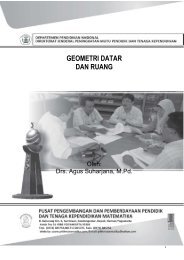25 Biggest Mistakes Teachers Make and How to Avoid Them
25 Biggest Mistakes Teachers Make and How to Avoid Them
25 Biggest Mistakes Teachers Make and How to Avoid Them
Create successful ePaper yourself
Turn your PDF publications into a flip-book with our unique Google optimized e-Paper software.
<strong>25</strong>6 <strong>25</strong> <strong>Biggest</strong> <strong>Mistakes</strong> <strong>Teachers</strong> <strong>Make</strong> <strong>and</strong> <strong>How</strong> <strong>to</strong> <strong>Avoid</strong> <strong>Them</strong><br />
Cushner, K., McCell<strong>and</strong>, A., & Safford, P. (1992). Human diversity in education: An integrative<br />
approach. St. Louis, MO: McGraw-Hill.<br />
DeCecco, J., & Richards, A. (1974). Growing pains: Uses of school conflicts. New York: Aberdeen.<br />
deCharms, R. (1976). Enhancing motivation. New York: Irving<strong>to</strong>n.<br />
Delgado-Gaitan, C. (1990). Literacy for empowerment: The role of parents in children’s education.<br />
New York: Falmer.<br />
Delpit, L. (1988). The silenced dialogue: Power <strong>and</strong> pedagogy in educating other people ’ s children.<br />
Harvard Educational Review, 58(3), 280–298.<br />
DeMott, R. M. (1982). Visual Impairments. In N. Haring (Ed.), Exceptional children <strong>and</strong> youth<br />
(pp. 271–295). Columbus, OH: Merrill.<br />
Dinkmeyer, D., & Losoncy, L. E. (1980). The encouragement book: Becoming a positive person.<br />
Englewood Cliffs, NJ: Prentice Hall.<br />
Dreikurs, R. B., Grunwald, B. B., & Pepper, F. C. (1982). Maintaining sanity in the classroom:<br />
Classroom management techniques (2nd ed.). New York: Harper & Row.<br />
Education of All H<strong>and</strong>icapped Children Act, Public Law 94–142. (1975). Individuals with<br />
Disabilities Education Act (IDEA). Last amended 1990 (P.L. 101–476).<br />
Eisenberg, N., & Harris, J. D. (1984). Social competence: A developmental perspective. The<br />
School Psychology Review, 13(3), 267–277.<br />
Elkind, D. (1989). Developmentally appropriate education for 4-year-olds. Theory In<strong>to</strong> Practice,<br />
28(1), 47–52.<br />
Epanchin, B. C., Townsend, B., & S<strong>to</strong>ddard, K. (1994). Constructive classroom management:<br />
Strategies for creating positive learning environments. Pacific Grove, CA: Brooks/Cole.<br />
Erikson, E. (1963). Childhood <strong>and</strong> society (2nd ed.). New York: Nor<strong>to</strong>n.<br />
Fl<strong>and</strong>ers, N. A., & Morine, G. (1973). The assessment of proper control <strong>and</strong> suitable learning<br />
environment. In N. L. Gage (Ed.), M<strong>and</strong>ated evaluation of educa<strong>to</strong>rs: A conference on California’s<br />
Stull Act. Stanford: California Center for Research <strong>and</strong> Development in Teaching.<br />
Froyen, L. A. (1993). Classroom management: The reflective teacher-leader (2nd ed.). New York:<br />
Macmillan.<br />
Gagne, R. (1977). Conditions of learning (3rd ed.). New York: Holt, Rinehart & Wins<strong>to</strong>n.<br />
Galloway, C. (1977). Nonverbal. Theory In<strong>to</strong> Practice, 16(3), 129–133.<br />
Garcia, E. E. (1995). Educating Mexican American students: Past treatment <strong>and</strong> recent developments<br />
in theory, research, policy, <strong>and</strong> practice. In J. A. Banks & C. A. M. Banks (Eds.),<br />
H<strong>and</strong>book of research on multicultural education (pp. 372–381). New York: Macmillan.<br />
Gardner, H. (1993). Multiple intelligences: The theory in practice. New York: Basic Books.<br />
Gearheart, B. R., Weishahn, M. W., & Gearheart, C. W. (1992). The exceptional child in the regular<br />
classroom (5th ed.). Upper Saddle River, NJ: Merrill/Prentice Hall.<br />
Gelman, D. (1983, November 7). A great emptiness. Newsweek, 102(1), 120–126.<br />
Gersten, R. (1996). Literacy instruction for minority students: The transition years. The<br />
Elementary School Journal, 96, 227–244.<br />
Gibbs, J. (1988). Young, black, <strong>and</strong> male in America: An endangered species. Dover, MA: Auburn House.<br />
Glaser, R., & Silver, E. (1994). Assessment, testing <strong>and</strong> instruction. Pittsburgh, PA: Learning<br />
Research <strong>and</strong> Development Center.<br />
Good, T. L., & Brophy, J. E. (1991). Looking in classrooms (5th ed.). New York: HarperCollins.<br />
Good, T. L., & Brophy, J. E. (1997). Looking in classrooms (7th ed.). New York: Longman.<br />
Gottfredson, G. D. (1984). <strong>How</strong> schools <strong>and</strong> families can reduce youth crime. Baltimore, MD: Center<br />
for Social Organization of Schools, Johns Hopkins University.<br />
Gronlund, N. E. (1995). <strong>How</strong> <strong>to</strong> write <strong>and</strong> use instructional objectives. Upper Saddle River, NJ:<br />
Merrill/Prentice Hall.<br />
Gronlund, N. E. (2000). <strong>How</strong> <strong>to</strong> write <strong>and</strong> use instructional objectives (6th ed.). Upper Saddle<br />
River, NJ: Merrill/Prentice Hall.<br />
Harvard University. (1988). Student questions in K–12 classrooms. Harvard Education Letter, (1), 7.<br />
Heath, S. (1983). Ways with words: Language, life, <strong>and</strong> work in communities <strong>and</strong> classrooms.<br />
Cambridge, MA: Cambridge University Press.





